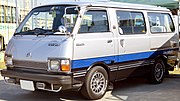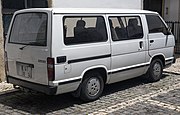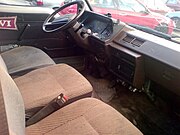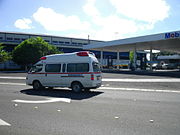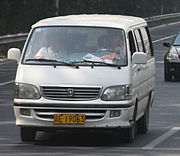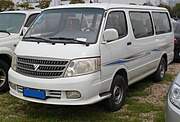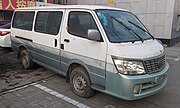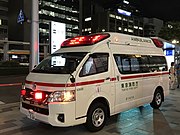Toyota HiAce
| Toyota HiAce | |
|---|---|
 A white Toyota HiAce van. | |
| Overview | |
| Manufacturer | Toyota |
| Production | Oct 1967–present[1] |
| Body and chassis | |
| Class | Light commercial vehicle Full-size van |
| Body style | Pick-up, double cab, van, minibus |
| Platform | H-series |
The Toyota HiAce is a light commercial van produced by the Japanese automobile manufacturer Toyota. First launched in October 1967, the HiAce has since been available in a wide range of body configurations, including a minivan/MPV, minibus, panel van, crew van, pick-up, taxi, and an ambulance. In Japan, the HiAce is exclusive to Toyopet Store locations.
First generation (H10; 1967–1977)
| First generation (H10) | |
|---|---|
 | |
| Overview | |
| Production | Oct 1967 – Jan 1977[1] |
| Body and chassis | |
| Body style | 2-door pickup 4/5-door van |
| Layout | FR layout |
| Related | Toyota ToyoAce |
| Powertrain | |
| Engine | |
| Dimensions | |
| Wheelbase | 2,350 mm (93 in) |
| Length | 4,305 mm (169.5 in) |
| Width | 1,690 mm (67 in) |
| Height | 1,890 mm (74 in) |
| Curb weight | 1,130 kg (2,490 lb) |

Introduced in 1967, the HiAce was offered as a cab over pick-up, delivery van, and a stretched commuter vehicle. It was also called the HiAce Commercial in camper van configuration. It was brought to market two years after the introduction of the Nissan Homy, acquired by Nissan when they assumed operations of the Prince Motor Company. A few engines of different sizes were available upon introduction, ranging from the 70 PS (51 kW) 1.35 to a 83 PS (61 kW) 1.6-liter version.[2][3] In 1975, the 1.8-litre 16R engine was added.
The HiAce was primarily designed as a commuter vehicle, able to transport up to 8 people. With this goal in consideration, the HiAce exterior dimensions and engine displacement were in compliance with Japanese Government regulations so as to encourage sales, and accommodate the most passengers by utilizing a cabover body style, with the engine installed underneath and between the front passengers. It was a smaller alternative to the larger Toyota Coaster minibus, and was introduced to Japan after the 1950 Volkswagen Transporter, and the 1961 Chevrolet Greenbrier cabover vans. It was introduced in the same year as the much smaller Toyota MiniAce, which was based on the Toyota Publica, a predecessor to the Toyota Corolla.

This type of HiAce is a rare model these days mostly because of weather wear and rust. HiAce vans originally sold on the European market have largely been exported to Africa where they are used as public transport vehicles.
Second generation (H11, H20, H30, H40; 1977–1982)
| Second generation (H11, H20, H30, H40) | |
|---|---|
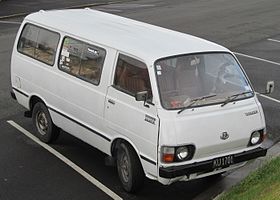 | |
| Overview | |
| Also called | Toyota Commuter |
| Production | February 1977 – Jan 1982 (van)[1] February 1977 – 1985 (truck) |
| Model years | 1978–1982 |
| Assembly | Toyota City, Japan |
| Body and chassis | |
| Body style | 2-door pickup 3-door van 4-door van 4-door pickup |
| Layout | Front engine, rear-wheel drive / four-wheel drive |
| Related | Toyota ToyoAce |
| Powertrain | |
| Engine | |
| Dimensions | |
| Wheelbase |
|
| Length | 4,340–4,990 mm (170.9–196.5 in) |
| Width | 1,690 mm (66.5 in) |
| Height | 1,890–2,115 mm (74.4–83.3 in) |
The new HiAce of 1977 featured a longer, and more streamlined cab with single headlights. As the second generations dimensions grew, it was joined by a smaller, junior-level cabover van called the Toyota LiteAce to continue to offer dimensions closer to the first generation. In addition to the petrol engine, a 2.2-litre diesel engine was offered in certain markets. New for the "20–40 series" HiAce was a double-cab pick-up, super-long-wheelbase van, and a super long, high-roof Commuter. The Commuter models can seat up to 15 passengers.[5] The short wheelbase truck initially carried the "H11"-series chassis codes. For the vans, 20 series vans have short wheelbases, 30 series have long, and 40 series are super long.
After the third generation was released in 1982, certain variants of the second generation continued to be manufactured for several years. Like the first generation, this type is also very rare now.
Third generation (H50, H60, H70; 1982–1989)
| Third generation | |
|---|---|
 | |
| Overview | |
| Also called | Toyota Commuter Toyota Shell (Sri Lanka) Toyota Siyaya (South Africa) |
| Production | Dec 1982[1]–1989 (H50/H60/H70 vans) 1985–1995 (H80/H90 trucks) |
| Assembly | Japan: Toyota City |
| Body and chassis | |
| Body style | 2-door pickup 3-door van 4-door van 4-door pickup |
| Layout | Front engine, rear-wheel drive / four-wheel drive |
| Related | Toyota ToyoAce |
| Powertrain | |
| Engine |
|
| Transmission | 4 speed automatic 4 speed manual 5 speed manual |
| Dimensions | |
| Wheelbase | 2,295–2,795 mm (90.4–110.0 in) |
| Length | 4,425–5,025 mm (174.2–197.8 in) |
| Width | 1,690 mm (66.5 in) |
| Height | 1,890–2,220 mm (74.4–87.4 in) |
A new HiAce van was launched in 1982, with the HiAce pickup truck coming in August 1985. The truck's cab design was common to the bigger ToyoAce light truck, though it had different frontal styling. The truck was a completely different model to the van.
The van's model number contains various wheelbase specification information: 50 series vans have short wheelbases, 60 series have long, and 70 series have super long. The pick-up trucks are in the 80 and 90-series. The Toyota Mobile Lounge, displayed at the 1987 Tokyo Motor Show, is based on the HiAce high-roof Commuter. While the van and Commuter were redesigned in 1989, the pick-up lasted until the 1995, and was the last HiAce pick-up.
Fourth generation (H100; 1989–2004)
| Fourth generation | |
|---|---|
 | |
| Overview | |
| Also called | |
| Production |
|
| Assembly | |
| Body and chassis | |
| Body style |
|
| Layout | Front engine, rear-wheel drive / four-wheel drive |
| Related | |
| Powertrain | |
| Engine | |
| Transmission |
|
| Dimensions | |
| Wheelbase | 2,330–2,890 mm (91.7–113.8 in)(Granvia) |
| Length | 4,430–5,250 mm (174.4–206.7 in)(Granvia) |
| Width | 1,695 mm (66.7 in) |
| Height | 1,920–2,285 mm (75.6–90.0 in)(Granvia) |
| Curb weight | 1,560–2,110 kg (3,439.2–4,651.8 lb)(Granvia) |
The fourth generation model appeared in mid 1989 and was available in standard wheelbase and long wheelbase variants; a Grand Cabin; standard wheelbase and long wheelbase van; long wheelbase and super long wheelbase high roof van. The latter shares a body design with the Commuter, which is a 15 seat minibus.
A range of engines were available in the 4th generation vehicles, ranging from 2.0-litre petrol engines to 3.0-litre turbo diesel engines. Most versions are rear-wheel drive, but part time or full time four-wheel drive versions were sold depending on specification level and market. The base model is typically the DX. Upmarket versions included CD, GL, and super GL models.
The facelifted fourth-generation HiAce was launched in May 1994. It was facelifted again during 1997 and once more in 2002.
In the Philippines, the HiAce was first sold in April 1995 with a diesel engine, getting revamped in May 1997 as it went from business status to family van status. In March 1999, the HiAce Grandia and 2.0 GL gasoline HiAce variants were launched, as well as the HiAce Commuter, a HiAce meant for business, and the HiAce was facelifted again in that year. In June 2001, the top-of-the-line 3.0 inline-4 diesel HiAce Super Grandia was launched. All came with a standard 5-speed manual transmission. These variants were all sold until June 2005, with the next generation being launched in June of that same year. A special edition HiAce Super Grandia J (Japan edition) was also sold together with the RAV4 J and Revo J from August 2002-June 2003.
This generation HiAce also remains popular in China, where it is still produced by Jinbei Motors, King Long Motors, and Foton Motor Company amongst others. These are exported to several markets, including Chile, and are also assembled in both Egypt (by Bavarian Auto Group) and Sri Lanka (as the Micro MPV J).[8] Common engines found in Chinese Hiace variants are the 2.0 and 2.2 litre (491Q-ME) petrol engines and the 2.8 litre diesel engine. A Chinese variant of the 2.4 L 2RZ-E engine is also available known as the 4RB2. The Isuzu 4JB1 engine and other engine names such as the V19, 4G20C and the 4G22 are available in China as well as 2.5 and 2.7 litre diesel engines.
- RegiusAce
The HiAce rebadged with a luxury orientation, the Toyota RegiusAce, was introduced August 1999 with different versions called the Regius HiAce and Regius Touring HiAce sold at Toyopet and Vista dealerships. The RegiusAce uses a cab over setup, meaning that front seat passengers sit on top of the front axle and the 1TR-FE engine is located underneath the floor and between the front passengers.
When the Vista sales network was replaced by the NETZ sales network, the Regius Ace was sold exclusively at the Netz Store. The first generation H100 series was manufactured between 1999–2004.
Granvia, HiAce Regius, Grand HiAce, Touring HiAce (XH10, XH20)

Sold in the Japanese market between 1995 and 2002, the Granvia is a semi-bonneted van, with the front wheels positioned in front of the front seats for better safety. Available with seven- and eight-seater configurations and in two-wheel drive or four-wheel drive, it is based on the regular HiAce. Because of tighter safety regulations, this model replaced the mid-engined HiAce in Europe and several other markets. The engines for Granvia are either a 2.4 L or 3.0 L diesel, or 2.7- and 3.4 L petrol. The Granvia spawned into the upmarket multi-purpose vehicles the HiAce Regius, the Grand HiAce and the Touring HiAce. The Granvia, Grand HiAce, and Touring HiAce are upmarket passenger vans only.
In Europe, the Granvia-based HiAce sold from 1995 was usually equipped with the 2494 cc 2KD diesel engine in a variety of versions, with or without turbocharging. The HiAce underwent a facelift in 2006, with bigger "jewel-style" headlights, and continued to be built in this form until 2012, replaced by the Toyota ProAce.
In Australia, the Granvia was sold as the HiAce SBV, alongside the fourth generation HiAce, and both were replaced by the new fifth generation model. The HiAce SBV sold in Australia (from 1999 to 2005) was designated RCH12R (short wheelbase) and RCH22R (long wheelbase) and was available only with 2.4-litre 2RZ-E petrol engine developing 88 kW at 4800 rpm and 200 Nm at 3600 rpm and five-speed manual transmission. The smaller SBV TownAce was powered by a 1.8-litre petrol engine.


They are also very popular in New Zealand, imported as used vehicles from Japan. The 3.0 litre turbocharged diesel is especially favoured as its enormous torque but not so impressive power output are ideally suited to the hilly conditions in a country with an overall 100 km/h speed limit. Many of these vehicles are in commercial passenger service.
The Grand HiAce was based on the HiAce Powervan. Sales of the Grand HiAce started in Japan in 1999. Engines available were a 3.4-liter petrol and a 3.0-liter turbo diesel. This type was sold in Japan only until 2002. In China the Granvia was badged "Toyota HiAce Solemio".
The semi-bonneted HiAce was sold in Norway and was the best selling van for many years until early 2012, when it was withdrawn from the market.[9] The Hiace sold in Europe will be replaced with a rebadged version of the Sevel (PSA, Fiat) Eurovan which will be sold as the Toyota ProAce.[10] It's made in cooperation with Jinbei as the Jinbei Grace.[11]
Fifth generation (H200; 2004–present)
| Fifth generation | |
|---|---|
 | |
| Overview | |
| Also called |
|
| Production | Aug 2004–present |
| Model years | 2005–present |
| Assembly |
|
| Body and chassis | |
| Body style | 3-door van/minibus 4-door van/minibus |
| Layout | FR layout |
| Powertrain | |
| Engine | 2.0 L 1TR-FE I4 134 hp 2.7 L 2TR-FE I4 158 hp 2.5 L 2KD-FTV I4 107 hp 3.0 L 1KD-FTV I4 142 hp 2.8 L 1GD-FTV I4 149 hp 3.0 L 5L-E I4 91 hp 2.2 L 4Y-E I4 94 hp |
| Transmission | 5-speed manual 4-speed automatic (Super ECT) 6-speed automatic (Super ECT) (2015–present) |
| Dimensions | |
| Wheelbase | 2,570 mm (101.2 in) |
| Length | 4,695–5,380 mm (184.8–211.8 in) SWB: 4,840 mm (190.6 in) |
| Width | 1,695–1,880 mm (66.7–74.0 in) |
| Height |
|
| Curb weight | 1,610–2,200 kg (3,549–4,850 lb)[40][41] |
The fifth-generation HiAce appeared in late 2004 as a wide long-wheelbase wagon, wide super-long-wheelbase high-roof "Grand Cabin", long-wheelbase van, long-wheelbase high-roof van and a wide super-long-wheelbase high-roof van. In this generation the gear lever has been moved to the dashboard to enable easier movement in the cabin. Five-speed manual and four-speed automatic transmissions are available.
Most models use a four-cylinder DOHC engine, in a variety of forms, a 1TR-FE 2,000 cc or 2TR-FE 2,700 cc petrol engine, or a 2KD-FTV 2,500 cc or 1KD-FTV 3,000 cc D-4D turbo diesel engine. Two of these engines are available in Malaysia, the 2.5 L turbo diesel, offered in a choice of panel van or window van; and the 2.7 L petrol, that comes only in the window van option. At least some general export market HiAces are powered by the 5L-E 3,000 cc diesel engine.
In Japan, Toyota's internet-enhanced GPS and vehicle telematics service called G-Book was made an option on all trim packages for both private and commercial uses.
The fifth-generation HiAce was launched in the Philippines on June 13, 2005, with D-4D variants, Commuter and GL Grandia, both with manual transmission. In March 2006, the new top-of-the-line HiAce Super Grandia was launched, being the first ever HiAce in the Philippines with a standard automatic transmission.
The 2.5 and subsequent 3.0-litre turbodiesel KD engines have a maximum output of 80 kW at 3,400 rpm and 106 kW at 3,400 rpm and maximum torque of 260 Nm at 1,600–2,600 rpm and 300 Nm at 1,200–3,200 rpm respectively.[42][43] The 2.0 L and 2.7 L TR petrol engine has a maximum output of 100kW at 5,600 rpm and 118 kW at 5,200 rpm respectively and a maximum torque of 182 Nm and 243 Nm both at 4,000 rpm. In November 2017 the Japanese market Hiace Van and RegiusAce received the 2.8 L 1GD-FTV mated to only a 6-Speed Automatic Transmission making 111 kW at 3,600 rpm and 300Nm of torque from 1,000 rpm to 3,400 rpm supplanting the 1KD-FTV.[44]
On Japan's list of the most commonly stolen vehicles the HiAce currently resides in first place. Because of a lack of a theft immobilizer, it is fairly easy to steal a HiAce, as opposed to much more valuable SUVs and sports cars, which have more sophisticated theft deterrent systems.[citation needed]
- RegiusAce
The second generation series H200 of RegiusAce was completely restyled and is currently in production. Transmission choices are a 5-speed manual transmission or a 4-speed automatic, with the gearshift lever integrated into the instrument panel so as to allow front seat passengers access to the rear of the vehicle from the inside. A moderate restyle was completed November 2005.
-
Long van 2.0 DX (TRH200V)
-
Interior with G-Book navigation
-
Toyota HiMedic
References
- ^ a b c d "Toyota Vehicle Identification Manual", Toyota Motor Corporation, Overseas Parts Department, Catalog No.97913-84, 1984, Japan
- ^ a b 愛される車づくり。トヨタはあすにいどみます。 [Lovable car manufacture. Toyota dares to defy tomorrow.] (in Japanese), Toyota Motor Co., 1972, p. 3
{{citation}}:|format=requires|url=(help) - ^ a b Toyota Catalog (1972), p. 6
- ^ "自動車ガイドブック [Japanese Motor Vehicles Guide Book 1978/1979]" (in Japanese). 25. Japan: Japan Automobile Manufacturers Association. 1978-10-10: 213. 0053-780025-3400.
{{cite journal}}: Cite journal requires|journal=(help) - ^ Automobile Guide Book 1978/1979, p. 294
- ^ https://web.archive.org/web/20111224223953/http://www.jiangnanauto.com:80/product_en.asp?action=productList&AlbumClass=1
- ^ "JINCHENG MINIBUS". Qinhuangdao Jincheng Automobile Manufacture Co. Ltd. Archived from the original on 2011-07-16.
- ^ "Micro Cars Limited". Microcars.lk. Retrieved 2010-07-19.
- ^ "Toyota Hiace-kundene er lei seg" [Toyota Hiace customers are upset]. Hegnar.no. 2012-05-22. Retrieved 2012-05-31.
- ^ "Toyota Looks to PSA Peugeot-Citroen and Fiat for its New ProAce LCV". carscoop. Retrieved 2012-10-20.
- ^ "Jinbei Grace MPV". ChinaAutoWeb. Retrieved 2016-09-20.
- ^ http://chinaautoweb.com/car-models/chery-rely-h3-mpv/
- ^ http://www.sgcarmart.com/news/review.php?AID=280
- ^ http://chinaautoweb.com/car-models/chery-rely-h5-mpv/
- ^ http://cheryinternational.com.my/model-maxime-Transcom.html
- ^ https://web.archive.org/web/20161127065249/http://ldv.higer.com:80/product_10.html
- ^ https://web.archive.org/web/20161229125413/http://ldv.higer.com:80/product_7.html
- ^ https://web.archive.org/web/20170304034216/http://higerusa.com/products/26/40/klq6540.html
- ^ https://web.archive.org/web/20061027055717/http://www.jinbei.com.cn:80/english/model/awing_overview.htm
- ^ http://chinaautoweb.com/car-models/brilliance-jinbei-haise-mini-bus/
- ^ https://web.archive.org/web/20121006042605/http://en.brilliance-auto.com:80/chanpina.aspx?id=10&typeId=2&status=1&mid=0
- ^ https://web.archive.org/web/20130425085104/http://en.brilliance-auto.com/chanpina.aspx?id=11&typeId=2&status=1&mid=1
- ^ https://web.archive.org/web/20170703185408/http://www.joylong.net/en/index.php?s=/Product/lists/related_id/3.html
- ^ "Placer-X". Sendok Group. Retrieved 2016-03-29.
- ^ https://web.archive.org/web/20121230195500/http://www.foton-global.com:80/bencandy.php?fid=71&aid=119
- ^ https://web.archive.org/web/20151203092737/http://www.foton-global.com:80/vehicles/view-cs2/
- ^ http://www.jincheng-auto.com
- ^ http://www.jc-auto.net/jianjieen.asp
- ^ https://web.archive.org/web/20150131105803/http://www.kinglong-bus.com:80/4-2-kingo-minivan.html
- ^ https://web.archive.org/web/20171004115541/http://kinglong-bus.com/4-1-kingwin-series-van/
- ^ http://www.foton.com.ph/products/traveller/
- ^ http://www.foton.com.ph/products/view-transvan/
- ^ http://www.kingstar.com.cn/index.php?m=product&a=car&carid=205
- ^ http://www.kingstar.com.cn/index.php?m=product&a=car&carid=261
- ^ http://www.kingstar.com.cn/index.php?m=product&a=car&carid=303
- ^ "Affiliates (Toyota wholly-owned subsidiaries)-Toyota Auto Body Co., Ltd". Toyota Motor Corporation. 2012. Retrieved 2015-05-01.
- ^ โตโยต้าเดินเครื่องปั้นคอมมิวเตอร์ในไทย18,000คัน. Siamsport (in Thai). 2013-01-10. Retrieved 2013-11-22. [dead link]
- ^ โตโยต้า ลุยผลิตรถตู้ ไฮเอซ คอมมิวเตอร์ แทนนำเข้า. Manager Online (in Thai). 2013-01-12. Retrieved 2013-11-22.
- ^ "Toyota Caetano Portugal: Assembly of Toyota Comercials (sic)". Grupo Salvador Caetano. Retrieved 2011-02-04.
- ^ http://toyota.jp/pages/contents/hiacevan/005_b_017/pdf/spec/hiacevan_spec_201711.pdf
- ^ http://toyota.jp/pages/contents/hiacewagon/005_p_011/pdf/spec/hiacewagon_spec_201711.pdf
- ^ "toyota.jp ハイエース". 2007-07-15. Retrieved 2017-12-03.
- ^ "トヨタ ハイエース バン | スペック・装備 | トヨタ自動車WEBサイト". 2017-03-26. Retrieved 2017-12-03.
- ^ CORPORATION., TOYOTA MOTOR. "トヨタ ハイエース バン | スペック・装備 | トヨタ自動車WEBサイト". toyota.jp (in Japanese). Retrieved 2017-12-03.


